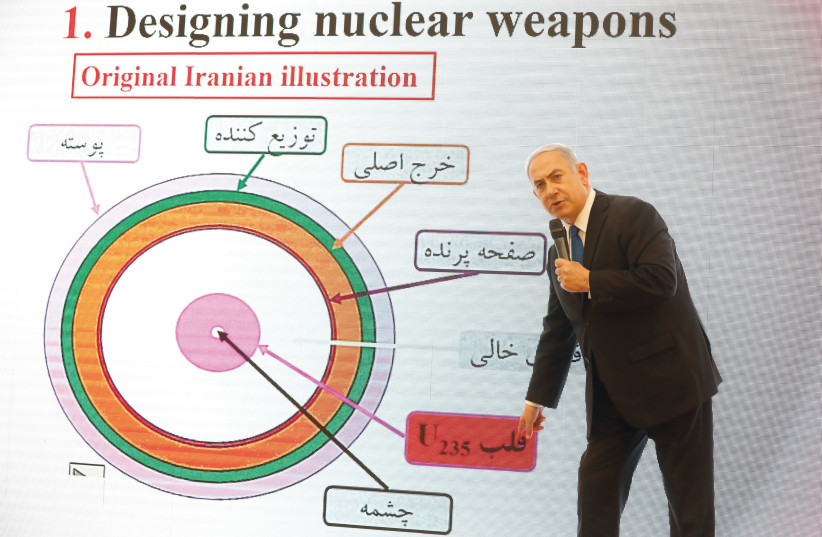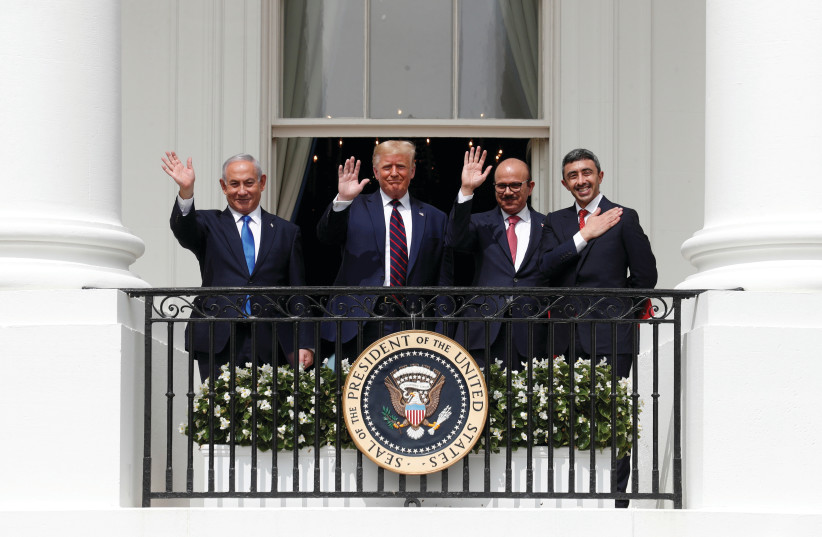Although significant aspects of the Mossad’s 2018 operations to seize Iran’s secret nuclear files were already previously revealed, there are some fascinating new nuggets in former prime minister Benjamin Netanyahu’s new book.
We learn that then-Mossad director Yossi Cohen first proposed seizing Iran’s secret nuclear files and bringing them to Israel to Netanyahu in a PowerPoint presentation in 2017.
Further, we learn about some of the back-and-forth between Netanyahu and Cohen at that secret meeting – which took place when essentially no one knew what Jerusalem had in mind for Tehran.
Did Iran have a copy of the nuclear files?

According to the book, the first question Netanyahu asked Cohen was “do they have a copy?”
“I don’t know,” he answered. “But they are so sure that no one knows about the existence of the archives, that it is very possible that they did not keep a copy of it.”
“You don’t think they would keep copies of all of the information backed up on computer files?” Netanyahu asked as a follow-up question.
Cohen responded, “Not if they believed that we could get at such computer files [using hacking capabilities]. Maybe they thought that hiding [only] the original paper files is the best defense.”
Netanyahu then makes clear that one of the key goals of the operation was to remove nuclear scientific data from the Islamic Republic that it might not be able to replace.
Ultimately, we know that the Iranians have managed to reconstitute aspects of their nuclear program sabotaged by the Mossad during that and other operations.
But the revelations of the discussions between Netanyahu and Cohen show that the operation was designed not only to prove to the world beyond any doubt that Iran’s nuclear program was military in nature, but also based on the belief that the program itself could be delayed by stealing information that was irreplaceable.
Even now, since there is less reporting on Iran’s nuclear weapons group’s activities, it is unclear regarding the full extent of whether this part of the mission succeeded.
More Mossad operation details revealed by Netanyahu
Netanyahu also reveals one new detail from the operation itself.
He writes that within hours of the heist, thousands of Iranians were searching for the Mossad agents. Further, he adds that when the Iranians got to one place where the Mossad had been, they had already moved on to another location.
This last detail makes it sound like Iran’s security forces were even closer on the heels of the Mossad agents, who were trying to escape, than was previously known.
Previously, Cohen had revealed that he updated Netanyahu as soon as some of the seized archives information started to arrive by sending photos of some of the material electronically from the field. But the book states that Cohen updated Netanyahu not once, but every few hours regarding the status of the operation.
US-Israel communications during Mossad operation
There has also been intense speculation about how and when Netanyahu’s team relayed its findings to the aides of then-US president Donald Trump.

According to the book, it was on March 5, 2018. At that meeting, Netanyahu and his team showed a video presentation to Trump and his top cabinet ministers and aides of their findings to date from the operation.
Netanyahu writes that Trump said he would have left the nuclear deal even without the Mossad’s proof of Tehran’s lies. Responding to the presentation, Trump told Netanyahu, “Maybe they [his aides] needed to see this, but I didn’t. I already decided to leave the nuclear deal.”
There is also a brief moment of disagreement between Netanyahu and Cohen about how and when to reveal the findings of the heist to Israel’s European allies.
Cohen had wanted to share the results of the heist with their intelligence allies before Netanyahu’s April 30, 2018 press conference, with the hope that the findings would lead them to support Trump’s leaving the nuclear deal, says the book.
“No way,” said Netanyahu, adding that the European governments would just say there was nothing new here and concentrate their efforts on convincing Trump not to leave the deal.
Curiously, this discloses the reason for the exact timing of Netanyahu’s “reveal” speech regarding the nuclear archives to the world: Netanyahu said he knew that making his presentation days after German chancellor Angela Merkel’s and French President Emmanuel Macron’s visits to Washington would neutralize their efforts.
Any public diplomacy value to their visits in trying to keep Trump in the deal would be quashed.
The Abraham Accords
Netanyahu specifically gives credit to Cohen for engineering a key meeting with Oman ruler Qaboos bin Said. It may not be a coincidence that Cohen singled out Oman and bin Said in a July 2019 speech as having jumped forward to somewhat more open diplomatic dealings.
Also, the book gives explicit credit to the Mossad for managing relations with Morocco over a long period and for key impacts with Bahrain.
It also makes vague references to keeping the Saudis updated on various diplomatic moves with the other Abraham Accords parties and to this being critical to the overall picture.
It is generally understood that the Mossad has handled these contacts – with the censor finally permitting publication earlier this year that Cohen and former Mossad chief Tamir Pardo had met with Saudi Arabia’s rulers.

Despite Netanyahu acknowledging Cohen and the Mossad’s role in aspects of the Abraham Accords, he implies that they were left out of the loop in the final sprint with the UAE.
According to Netanyahu, only three Israeli officials besides him knew about the final negotiations in Washington in the summer of 2020, which led to the breakthrough signing with the UAE.
He mentions then-ambassador to the US Ron Dermer (the lead negotiator), National Security Council chief Meir Ben-Shabbat and close confidant and minister Yariv Levin. Cohen and the Mossad are not on the list.
Cohen declined to comment on the matter.
Bibi: My Story came out in Hebrew on Friday, and is set to be released in English on Tuesday. The quotes in this article are translated from the Hebrew version.
